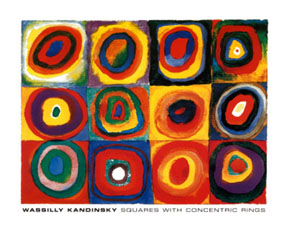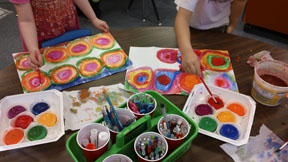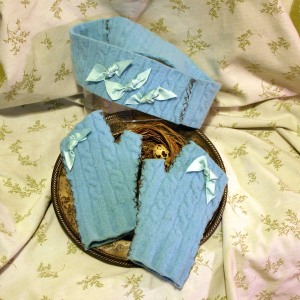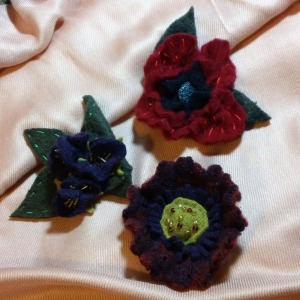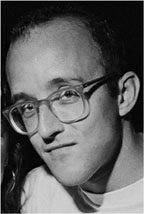 I have fallen in love with the art of Keith Haring. It just makes me happy. I love the simplicity of his art, as well as the messages he sends to us of tolerance and unity through his images. He has left a wonderful legacy of images that represent love an
I have fallen in love with the art of Keith Haring. It just makes me happy. I love the simplicity of his art, as well as the messages he sends to us of tolerance and unity through his images. He has left a wonderful legacy of images that represent love an d positive messages. How can you not help but smile when you look at his art?
d positive messages. How can you not help but smile when you look at his art?
In the classroom, we focus on how Keith Haring shows movement, as well as the simplicity of his art. He generally uses bright and solid primary and secondary colors and lots of color … hardly any white space … and outlining his images in black. There are very few details in most of his work and he does a great job of showing movement through the placement of lines. We also talk about “underground” art and street art, which is how Keith Haring became noticed – with his N.Y. Subway wall murals. Even though “street” art is sometimes considered grafitti and the artists can’t sign their names, they have their own icon or symbol so people know who was the “contributor”. Keith Harings was known as the Radiant Baby. 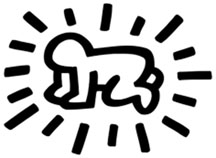 You can see how Haring included it as a “signature” in much of his early work.
You can see how Haring included it as a “signature” in much of his early work.
The artwork we actually do is another “new” form of art… Artist Trading Cards. Just like baseball, football, Pokeman cards, artists create their own Art Cards to trade with other collectors and artists in the medium they are known for. There are actual conventions held for trading!
We did ours in the Keith Haring style of something or someone in “motion”, simply using Sharpies for the flat color Haring always used. After focusing on the art and outlining everything in black, students made sure they included their lines that showed motion.
They turned out fabulous, if I do say so myself!

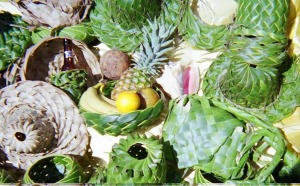




 My son, who is very interested in street artists, recommended I watch the movie, “Exit through the Gift Shop”. The movie was nominated for an Academy Award for Best Documentary and I watched the movie this past rainy day weekend thinking it was going to simply be a documentary on this counter-culture underground movement called Street Art. It was so much more … at the end of the movie you should ask yourself two questions, “What is Art?” and “Who decides it’s Art?” There has been a lot of speculation as to whether or not the movie is “real” or not … I’m not sure it really matters, in the end.
My son, who is very interested in street artists, recommended I watch the movie, “Exit through the Gift Shop”. The movie was nominated for an Academy Award for Best Documentary and I watched the movie this past rainy day weekend thinking it was going to simply be a documentary on this counter-culture underground movement called Street Art. It was so much more … at the end of the movie you should ask yourself two questions, “What is Art?” and “Who decides it’s Art?” There has been a lot of speculation as to whether or not the movie is “real” or not … I’m not sure it really matters, in the end.
 Last week I visited the fantastic exhibit at the Legion of Honor in San Francisco … Pulp Fashion by Belgian artist, Isabelle de Borchgrave. The fashion was life-size period costumes made from nothing other than paper and paint (of course it was either glued or stitched together). Not only did I thoroughly enjoy her beautiful, realistic creations, but I really apprec
Last week I visited the fantastic exhibit at the Legion of Honor in San Francisco … Pulp Fashion by Belgian artist, Isabelle de Borchgrave. The fashion was life-size period costumes made from nothing other than paper and paint (of course it was either glued or stitched together). Not only did I thoroughly enjoy her beautiful, realistic creations, but I really apprec Beads and hair pieces, and even the hair itself, if necessary, was made from paper. Every piece was a little different and had a different flair and inspiration. All the pieces were exhibited on simple paper mannequins.
Beads and hair pieces, and even the hair itself, if necessary, was made from paper. Every piece was a little different and had a different flair and inspiration. All the pieces were exhibited on simple paper mannequins. last exhibit room was a presentation of costumes De Borchgrave created using actual paintings in the Legion of Honor for inspiration. They were incredible!
last exhibit room was a presentation of costumes De Borchgrave created using actual paintings in the Legion of Honor for inspiration. They were incredible!














